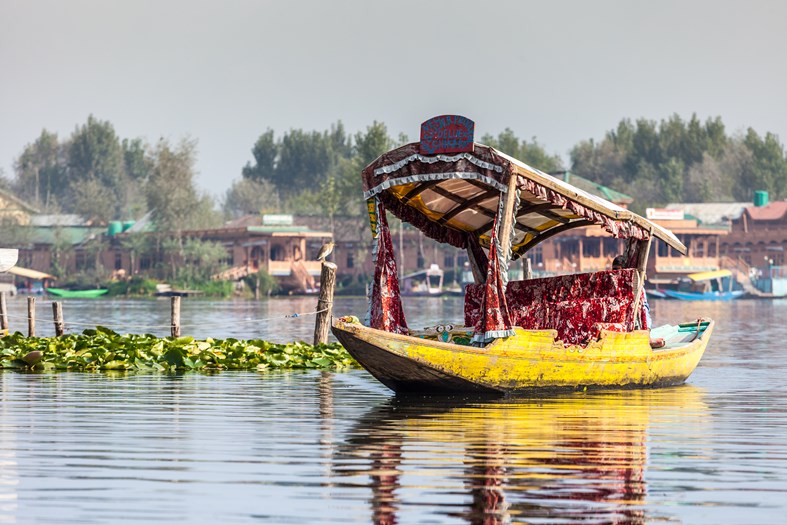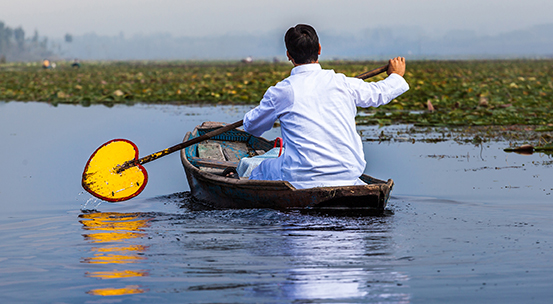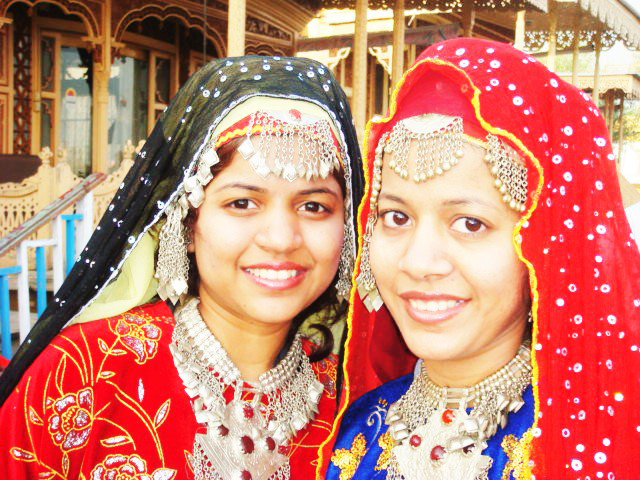SRINAGAR, INDIA - The moment I land at the airport in this Kashmiri outpost, which is dominated by majestic mountains and lakes, a driver picks up my family and takes us directly to the houseboat moored on nearby Dal Lake, where we’ll be staying for the next few days.
From the shore, my anchored accommodation looks like any houseboat — big and cumbersome. But inside it’s a floating palace filled with intricate traditional walnut woodcarvings, old British-era sofas with carved wooden arm rests, and lots of lovely paintings.
This houseboat is more a home away from home.
I booked the houseboat for my family because we wanted to experience the Kashmiri lifestyle, eat the fabulous food of Northern India and delve into the culture of these fascinating people with the long and distinguished history.
We’re welcomed with a pot of traditional tea — kahva — and, after resting a while, I’m excited to start exploring the area around where the houseboat is anchored. I take a small boat known as a shikara — it’s meant for local excursions and is fitted with a canopy to keep the sun off passengers — to the local market, which is spread along the banks of legendary Dal Lake. Because Srinagar is considered the summer capital of the Jammu and Kashmir states, there’s always lots of people vacationing in this incredible valley guarded by the Zabarwan Mountain Range. The waters of Dal Lake are usually crammed with the small shikara boats.


Above: Shikara boats In Dal Lake.
I spend my time at the market admiring the fresh fruits, vegetables and flowers and inhale the vibrant scents of the spices displayed in wicker baskets. The local sellers and buyers are polite and extremely helpful to the visitors in their midst, and it doesn’t take long for me to feel accepted.
I arrive back at the houseboat just as the sun is beginning to set behind famed the Shankaracharya Temple, which sits on a hilltop overlooking the brilliance of Dal Lake. The shikaras returning home are silhouetted on the water, which has turned orange by the sun. The view I’m afforded from the deck of the houseboat is simply breathtaking.
The houseboat owner encourages us to don traditional Kashmiri attire before dinner so he can take a group photo. The colourful costume makes me feel like a Kashmiri princess and the evening ends with me in my yellow sari gazing out over the valley that many people describe as Heaven on Earth.

Above: Sweta and her mom in traditional garb.
My first few hours on the houseboat have been so rewarding I decide I want to see everything the Kashmir Valley has to offer. Over the next few days, my family and I explore many breathtaking sights.
First up, the beautiful Mughal Gardens, a wonderland of flowers and shrubs built in the Persian style for the enjoyment of the Mughal kings that ruled this part of India for so long. The gardens also showcase the artistic brilliance of the Kashmiris — carvings, carpets and fine embroidery are displayed throughout the area.
Gulmarg, another beautiful Kashmiri town, is where I travel to the top of one of its highest peaks on a ropeway — what a thrill — so I can get spectacular, uninterrupted views of India and Pakistan between two snowcapped mountain ranges. From my vantage point I clearly see white army bunkers on both sides of the border and can’t imagine the extreme temperatures the soldiers must cope with while defending their respective nations. It’s here, on Gulmarg mountain, that I display my own bravery — my first ski lesson.
Next stop: Sonamarg, a town nestled in a valley that is surrounded by mountains which are a rainbow of colours because of the mineral deposits locked in their stone. I’m really feeling adventurous now and jump on a horse for a ride.
We set out for Leh — a 419-km drive over some treacherous Himalayan terrain. The exhausting journey takes two days to complete but is well worth the effort — the jaw-dropping scenery and the picturesque towns we encounter along the way makes it all worthwhile.
One of the towns we stop at is Kargil, the sight of the infamous battle between India and Pakistan in 1999 that cost hundred of lives. A tour guide, who was in the army at the time, escorts me through the battlefield sites and his description of the fierce fighting gives me goose bumps. Even now, because of heightened tensions between the two nations, Kargil remains a high-security zone and the soldiers are always on high alert.
The war museum at Kargil brought tears to my eyes as I read letters from fallen soldiers written to their parents. On the wall of the museum is a message that reads: “We live in peace and tranquility, secured in our houses because they guard and lay life down for us.” Thankfully, their sacrifices have not been forgotten.
As we climb higher into the mountains en route to Leh, the temperature gradually falls, the air gets thinner and the winding road keeps getting narrower. When we stop at the Khardungla Pass before descending via the highest road in the world into Leh, signs warn of a lack of oxygen at this elevation — 5,500 metres above sea level — and that travellers should take the descent into the city slowly.

Above: The Khardungla Pass.
We heed the advice and slowly drive towards the city that once was a trading post but now serves as the capital of the Jammu and Kashmir states. Just before entering Leh, though, we come upon Magnetic Point, a small stretch of road — about 36 metres long — that defies gravity. With our vehicle in neutral, the vehicle seems to roll uphill, against gravity. It’s a phenomenon, actually an optical illusion, that also takes place on New Brunswick’s Magnetic Hill just outside Moncton.
Even though Leh is an important state capital, the roads into this remote city with the fabulous panorama are lined with lots of wildlife — emus, nilgai (Asian antelope), yaks, mountain squirrels and lots of goats act as a reception committee for our small troupe.
Because Leh straddles the Tibet border, it’s renowned for its Buddhist temples, many of which I see sitting like crowns atop majestic hills overlooking the city. Leh is where the Dalai Lama had his headquarters and the people live a simple Buddhist lifestyle — they are especially welcoming and hospitable to strangers.
When we check into the Hotel Lasermo, there’s a warm Tibetan welcome waiting for us. Silk scarfs are put around are necks and we toast our amazing journey with apricot juice. From the balcony of our fashionable room we are afforded awe-inspiring views of the snow-capped Himalayans off in the distance. Amazingly, they change colours when the sun rises and sets.
No visit to Leh would be complete without a stop at Pangong Lake, a breathtakingly beautiful body of water in which the Himalayan mountains are reflected in the turquoise surface. The Lake looks more like an ocean and a guide tells us that 65 per cent of the crystal-clear water actually lies across the border in China.
The following day we travel to Alchi, where we explore a 1,200-year-old monastery, believed to be one of the oldest in the area.
The monastery features thousands of miniature paintings that the monks created — the vibrant colours have survived time and the elements. When the monastery bells ring, I feel like I’m in a mystical place lost in time.
After reluctantly leaving Leh, we travel another 120 kilometres until we reach the Nubra Valley — elevation 3,352 metres — which sits nestled in the bosom of the mighty Himalayas.
Awesome is about the only word that truly describes what one sees in this fertile place, where we stay in a tent nestled in an apricot orchard that’s surrounded by a babbling brook. Talk about serenity.
It’s in the Nubra Valley where I take a ride on a double-hump camel and get an elevated look at the stunning surroundings from atop the lumbering gentle giant.
The only problem with this incredible trip is that it has to end. On the final day we drive back to Srinagar, where we catch a flight to Delhi, our final stop.
This has been a journey of a lifetime that has changed my life forever.